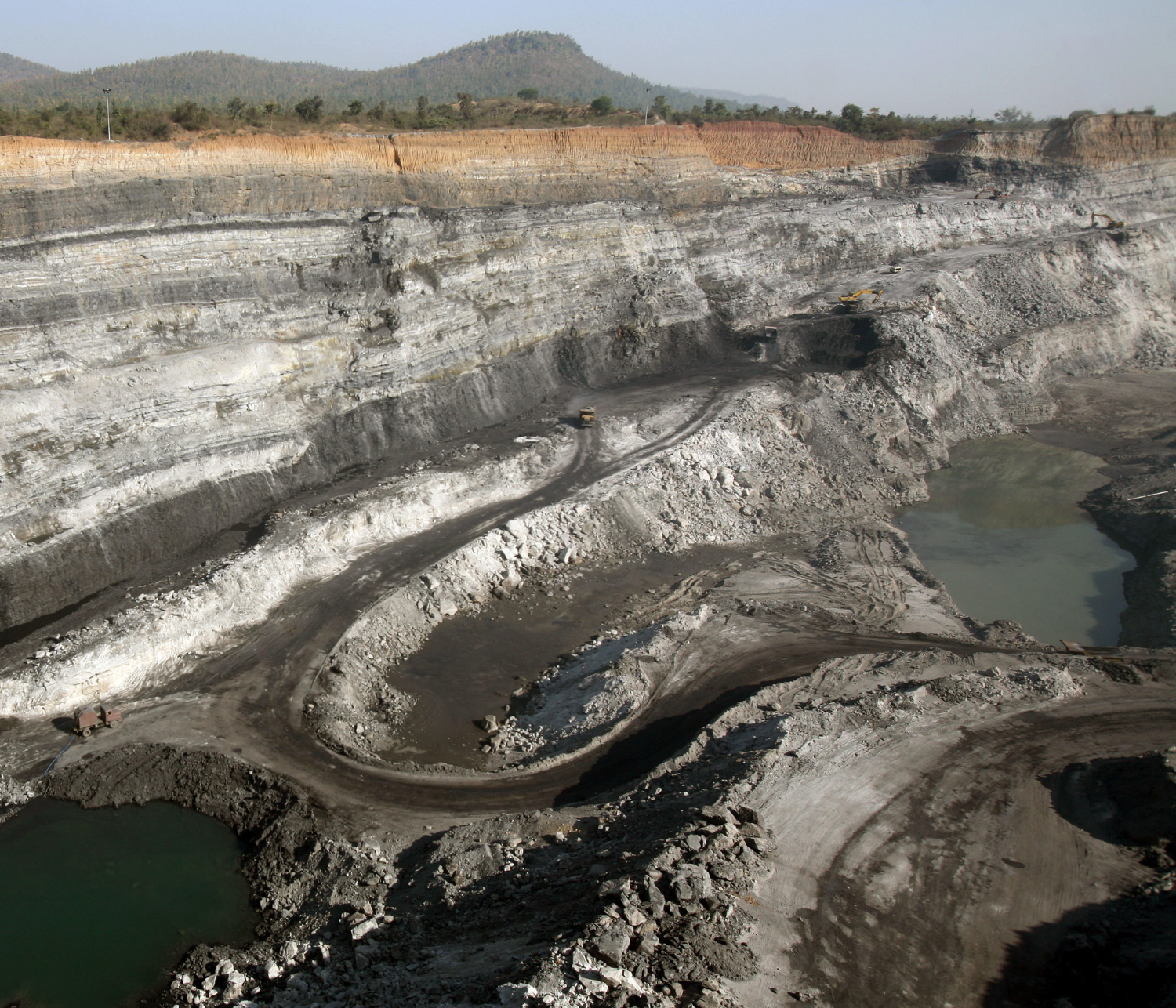
Coal mine methane’s critical moment in India
With plans to enhance energy self-reliance this decade, India faces a pivotal opportunity to address coal mine methane
Highlights
Executive summary
India’s pivotal opportunity to address coal mine methane
Plans to increase coal mining by 2030 will markedly impact methane emissions, highlighting the need for a robust national policy to address coal mine methane.
India is now home to the 3rd largest solar power generation in the world, but unprecedented increases in electricity demand are outpacing the capacity for renewables to bridge the growing electricity gap.
India is currently the world’s second-largest producer, importer and consumer of coal. It is also one of the biggest emitters of methane from coal mining. To meet rising energy demand and reduce coal imports, India’s Ministry of Coal is planning a significant expansion in domestic coal mining, alongside its considerable renewable energy expansion. If implemented, it could see domestic coal mining reach annual production levels that are more than 2.2 times higher than the rate when the Paris Agreement was agreed.
The proposed increase will have a significant effect on the total amount of methane emitted in the process of mining coal. Notably, higher-emitting underground mining is currently proposed to triple, potentially exceeding 100 million tonnes (Mt) per year.
However, this also represents a pivotal opportunity.
To match existing ambition in the renewables sector, India could begin a progressive effort to reduce coal mine methane emissions by up to 35% per year by 2030. If gradually implemented as early as next year, it could result in a cumulative reduction of more than 1.6 million tonnes of methane, equivalent to over 44.5 million tonnes of CO2e.
Using the methodology outlined in the national emissions inventory, Ember projects that the expansion of both surface and underground mining may lead to a more than doubling of coal mine methane emissions from 812 kilotonnes (kt) in 2019 to over 1670 kt by 2029.
If unaddressed, this poses a considerable risk for the country’s domestic emissions reduction plans and will have a profound short-term warming impact.
Building on several international assessments of India’s technical capacity to mitigate these emissions, this report seeks to outline a roadmap to capitalise on this pivotal opportunity. We estimate that a moderate roll out of coal mine mitigation technologies across underground and surface coal mines could save more than 1,600 kt of methane between 2025 and 2030.
If regulatory reforms and incentives were innovatively applied to enable this methane to be captured and utilised, it could replace approximately 1.5 billion cubic metres of imported gas, potentially saving up to $980 million USD over the next five years.
Considering the potential growth of coal mining in the years ahead and the critical opportunity to mitigate and utilise coal mine waste gas, emphasis should be placed on urgently developing an integrated approach to assess and implement coal mine methane mitigation measures across all current and proposed coal mines.
Key takeaways
Planned coal production to exceed 1.5 billion tonnes
India is already the world’s second biggest coal producer and is planning to double its coal production this decade, reaching an annual production rate of more than 1.5 billion tonnes per year.
Coal mine emissions could more than double this decade
The proposed increase in coal mining will lead to a significant increase in coal mine methane emissions, as high-emitting underground mining is projected to triple by 2029. As a result, total coal mine methane emissions are set to increase by 106% since their last national estimate in 2019.
$980 million USD potential savings in imported gas
Ember’s gradual methane mitigation roadmap estimates that India could progressively mitigate up to 35 percent of its coal mine methane by 2030. If this rate of cumulative methane mitigation was captured and utilised, it could supplement close to $980 million USD in imported gas this decade.
Greater climate impact than trucks
By 2029, estimated coal mine methane emissions could exceed 1.67 million tonnes of methane (Mt CH4) per year. Due to methane’s powerful short term warming impact, the relative climate impact over a 20 year period could be comparable to the CO2 emissions of all of India’s trucks and buses.
Chapter 1 | Historical production
Coal mining growth has not yet led to a significant increase in methane emissions
Coal production increases between 2010-2019 have only marginally increased methane emissions, primarily due to a significant decrease in underground coal mining
Coal mine methane is an umbrella term referring to methane released from coal seams during and after mining. This gas, formed during the coalification process, is stored within the coal substrate and escapes into the atmosphere as a result of mining operations. Within the coal mining industry, it is often also referred to as coal mine waste gas.
Between 2010 and 2019, overall coal mining in India increased by 28 percent. This shift saw total production increase from 601 million tonnes in 2010 to 773 million tonnes by the end of the decade.
Despite this increase in production, national estimates of coal mine methane rose by only 4 percent. This was due to a clear shift in the type of mining, with several older, gassier underground mines retiring and a substantial increase (+ 38%) in shallower, surface coal mining.
Underground mining decreased by 71%, producing just over 40 million tonnes of coal by 2019. However, it is estimated that these gassier underground coal mines still accounted for nearly 20% of India’s total coal mine methane in 2019.
Conversely, surface mining, which typically releases less methane, saw a 38% increase in production, adding 200 million tonnes to annual mining production by 2019.
This shift toward surface mining helped mitigate the potential rise in methane emissions associated with increased underground mining.
Chapter 2 | India’s recent production changes
Recent coal production has grown dramatically, and may continue
With a push to reduce import dependence and boost production, coal mining is now growing at an unprecedented rate, driving up coal mine methane emissions
Over the last 3 years, reported coal production has grown significantly, increasing by 28% since 2020, replicating the growth of the previous decade.
This increase is largely due to preferential government policies designed to meet rising demand for power and to fuel the rapidly expanding steel sector. As a result, coal production has risen by more than 12 percent annually, aligning closely with the 13.5% increase in coal consumption between 2021 and 2022.
In June 2020, 41 coal mines were auctioned under the auspices of a major policy shift enabling commercial coal mining for the first time.
This policy shift was aimed at addressing what were perceived to be the inefficiencies and transparency issues of the previously limited coal mining landscape, which were described as being “entangled in the mesh of captive and non-captive” limitations for coal mining. In announcing the policy shift, India’s coal supply was compared to China’s, including a broad aspiration to become a significant global exporter.
India’s coal production has historically been focused on meeting domestic demand, but Coal India has indicated plans to ramp up exports across key South Asian countries. The policy shift, as well as the corresponding increase in domestic consumption, illustrates the broader shift accelerating coal production since 2020, with the reported opening of at least 22 new coal mines since 2015. This development underscores the longer-term shift towards increasing coal output in the post-COVID era.
A shift to a new era of coal production
India’s energy demand is growing rapidly, with coal-based power generation projected to increase from 212 GW in 2023 to 260 GW by 2031, according to the latest National Energy Policy. In response, the Ministry of Coal has outlined plans to increase domestic coal production “in order to meet the peak energy demand”. This was also reinforced by the IEA earlier this year, as the growth in renewable energy has been “unable to keep pace with the growth in power demand” due to ongoing heatwaves and reduced hydropower output.
These plans indicate that total domestic coal production could surpass 1.5 billion tonnes by 2030. Subsequent reporting has also outlined plans from the Ministry to triple underground mining as part of this broader mining expansion, potentially exceeding 100 million tonnes of underground production per year. In order to meet this level, underground coal production would need to grow by more than 20% per year.
While this rate of growth will be challenging, it is not expected to exhaust existing coal supplies. According to government estimates, there are approximately 188 billion tonnes of proven coal reserves that are economically viable for mining.
According to the IEA’s most recent mid-year coal update, India’s coal production grew by 12% in the last year, increasing by 116 million tonnes. While Coal India has increased its production by close to 10% in the last year, increased production from captive and commercial mines has been the driving force behind growth in the last year.
Additional production from newly opened commercial coal mining has also added to confidence that thermal coal demand may be supplied entirely through domestic production by as early as next year.
Coal mine emissions could more than double under new production plans
The parallel expansion of underground and surface coal mining would have a considerable impact on coal mine methane emissions. According to India’s most recent estimate, coal mines emitted 810 thousand tonnes of methane in 2019. Since that time, coal mining production has increased, but the relative share of underground coal mine production has declined.
Utilising the same methodology outlined in the national emissions inventory, Ember has projected how planned production increases in both surface and underground mining could impact coal mine methane emissions. Under existing plans, India’s coal mine methane emissions could more than double this decade.
As a result, India’s coal mines could emit over 1.6 million tonnes of methane per year by the end of the decade if production targets are achieved with no additional mitigation. In cumulative terms, more than 10 million tonnes of methane could be released from coal mines between now and 2030.
Prioritising coal mine emissions in India’s decarbonisation efforts
The projected increase in annual coal mine methane emissions by 2029 could have the same long term warming impact as releasing 49 million tonnes of CO2 equivalent (MtCO2e). However, due to methane’s relatively short atmospheric lifespan and its significantly higher global warming potential compared to CO2, its short-term warming impact over a 20-year period could be equivalent to 138 Mt CO2e.
To put the magnitude of these fugitive emissions from coal mining into perspective, heavy-duty transport vehicles (freight trucks and buses) were responsible for half of India’s transport emissions. The IEA estimated the sector’s total CO2 emissions in 2021 were equivalent to 280 Mt. As such, the projected fugitive emissions from coal mining could have a comparable short-term warming impact as all of India’s trucks and buses.
These heavy-duty vehicle emissions account for about half of the transport sector’s total emissions and are among the toughest vehicles to decarbonise in the coming years.
While India’s efforts to decarbonise the transportation sector are commendable, insufficient attention has been given to mitigating emissions from coal mining—a low-hanging opportunity that can be gradually addressed with existing technology. Considering the additional impacts of surface level ozone on human and crop health, the parallels with the transport sector become even more evident.
Both sectors contribute significantly to air pollution and public health issues, underscoring the need for a comprehensive approach to emissions reduction that includes not only advancements in clean transportation but also targeted interventions in coal mining practices to safeguard both environmental and human health.
The absence of a well-defined and robust policy framework for coal mine methane mitigation has the potential to undermine the considerable efforts to improve efficiencies and decarbonise the transportation sector. Considering this, we believe that urgent attention to address coal mine methane is not only an important element of India’s broader decarbonisation efforts but also a critically efficient strategy that can yield significant environmental and economic benefits, enhancing the overall impact of India’s climate policies.
Chapter 3 | Methane abatement and safety
Risks and mitigation opportunities
Coal expansion plans present safety and emissions risks, but they also offer considerable opportunities for methane mitigation
Mitigation is a critical step to minimise the powerful short term warming impacts of methane. Despite initial efforts, India has yet to develop a successful commercial-scale coal mine methane mitigation project.
To date, mitigation implementation has been limited to pre-feasibility studies and pilot projects in gassy coalfields like Moonidih and Sawang. Funding constraints and technical challenges hindered previous attempts to mitigate methane emissions. However, a well-defined and robust national policy could serve as a catalyst for effective mitigation efforts.
Several studies by researchers Ajay K. Singh and Jaywardhan Kumara have indicated high potential for profitable mitigation projects in several existing and expanding coal fields, including Raniganj, Jharia and East Bokaro. The IEA also estimated this year that up to 35% of India’s coal mine methane could be abated across both underground and surface mines. If implemented at scale, this could mitigate 2,689 kt of methane between now and 2030.
This is supported by analysis from the US Environmental Protection Agency (US EPA) in 2019, and the International Institute for Applied Systems Analysis (IIASA) in 2020, which have suggested that the technical mitigation potential for India’s coal mines could reach between 720 – 780 thousand tonnes of methane annually by 2030. We do however note considerable differences in their estimated mitigation costs.
Recognising the technical and financial challenges of implementing large scale mitigation in India’s current and future suite of coal mines, we have outlined a conservative mitigation roadmap that would still achieve considerable scale this decade. This does not seek to replicate efforts to estimate the total mitigation potential, but outlines a pragmatic opportunity for the Indian coal sector to progressively tackle its methane pollution.
Under our projected mitigation scenario, we estimate that it would be feasible to begin to mitigate seven percent of estimated coal mine methane by the end of 2025, with an additional seven percent mitigation increase each year between now and 2029. This aligns with the IEA’s projected 35% mitigation potential, but proposes a gradual progression towards that goal.
This conservative yet practical mitigation scenario has the potential to gradually mitigate a total of 1,666 kt of methane over the next five years, aligning India’s coal industry with national efforts to reduce carbon dioxide across the energy sector.
The value of mitigation and utilisation could be significant
Ember’s projected mitigation pathway could reduce the equivalent of more than 44.5 million tonnes of CO2e. Capturing and utilising methane from India’s coal mines could also prove profitable. In the last financial year, more than $13.3 billion USD was spent importing close to 31 billion cubic metres of gas.
If the IEA estimates of coal mine methane mitigation capacity were not only fully realised, but that methane was captured and utilised, it could have replaced close to 1.5 billion cubic metres of imported gas, and facilitated local job creation. While technically challenging, this could have saved $220 million USD. This annual saving would rise to over $1 billion USD per year by 2029, based on 2023 prices.
Under the more conservative mitigation scenario presented in this report, we estimate that a moderate roll out of coal mine methane mitigation technologies across underground and surface coal mines could save more than 1,600 kt of methane between 2025 and 2030. If this gas was captured and utilised as electricity, offsetting the use of imported gas, it could save up to $980 million USD over the next five years.
The ongoing construction of a 2,000 km pipeline from Jagadishpur to Haldia could also be utilised to transport coal mine waste gas, as it will run proximal to the coalfields of the Damodar Valley, as well as those in Jharkhand, West Bengal and Odisha.
Reducing safety risks with planned underground expansion
Coal mining is inherently dangerous, but underground mines present far greater safety risks to workers, especially relating to the increased risk of methane explosions and asphyxiation. Methane related incidents may have caused more than half of all coal mining deaths in India since 1980. In 2006, a methane explosion at Bhatdih underground mine killed 50 miners.
Non-lethal accidents causing serious injuries are also significantly higher in underground mining. In China, over three-quarters of coal mining accidents over the past decade occurred in underground mines. Our analysis identifies a similar pattern in India, where the decline in underground mining from 2015 to 2021 has led to a significant decrease in accidents and fatalities across Coal India Limited mines. This positive trend could be jeopardised if underground mining expands rapidly to meet growing demand.
Conclusion
Opportunities for India’s coal industry
The planned expansion in coal mining over the next few years could lead to a significant increase in coal mine methane emissions, if not proactively managed and mitigated.
This represents a pivotal opportunity for India’s coal industry.
At current projections, the planned expansion could more than double coal mine methane emissions by 2030, to over 1.6 million tonnes of methane per year. This will have a powerful short term warming impact on the climate, surface level ozone, as well as significantly increase the risks of accidents at coal mines.
However, this also presents considerable opportunities to proactively reduce risks and implement widespread mitigation measures across underground and surface coal mines, with the potential to achieve substantial energy savings through coal mine waste gas utilisation.
There has already been significant progress on mapping out this potential.
With the support of the United Nations Development Programme (UNDP) and The Global Environment Facility (GEF), Coal India Limited had successfully demonstrated the potential for utilising coal mine methane.
A number of longstanding partnerships with Australia’s CSIRO have also sought to explore and implement coal mine mitigation technologies on underground mines. There is also a twenty year history of collaborations and capacity building workshops with the US EPA, and ongoing representation from the Ministry of Coal at this year’s Global Methane Forum. The challenge now is to build on this long-standing experience and capture the pivotal opportunity to implement practical and efficient methane reduction at scale.
This will require a robust national policy to address coal mine methane emissions, including incentives, regulatory reform and proactive investment. Considering the scale of projects coming onboard in the next few years, we are at a critical juncture to ensure that new mine expansions carefully consider and implement mitigation measures that will significantly abate methane emissions and their critical short term warming impact.
Supporting materials
Downloads
Download the full report PDF
Methodology
We analysed data from various sources to assess the potential future impact of coal mining on methane emissions in India. These include United Nations Framework Convention on Climate Change (UNFCCC), India’s Coal Ministry, Directorate General of Mines Safety (DGMS), International Energy Agency (IEA), Global Energy Monitor (GEM) and academic research from Singh et al.
The data on national coal production by type of mine (surface & underground) was sourced from Statistics of Mines in India Vol. I (Coal), DGMS, 2015 (for the years 2010 to 2014), India’s official reporting to UNFCCC (for the years 2015 to 2019), and Ministry of Coal – Govt. of India (for the years 2020 to 2022).
It is important to note that discrepancies exist between Coal Ministry and UNFCCC data on coal production (total, surface, and underground) for 2016 & 2019. The reasons for these discrepancies are unclear. However, we use the UNFCCC reported data as it directly corresponded to the coal production figures used to estimate India’s official coal mine methane emissions.
We relied on UNFCCC data and the work of Singh et al. 2015 for referring to the division of total underground coal production for Degree-I, II & III mines. However, the division of total underground production for Degree-I, II & III mines was not available for the years 2013, 2014, 2020, 2021 and 2022. As a result, we scaled the share of Degree-I, II & III mines proportionally to the most recent year for which the shares were available.
Degree classification of underground mines in India
Degree-I: The percentage of inflammable gas in the general body of air does not exceed 0.1 and the rate of emission of methane does not exceed one cubic meter per tonne of coal produced. 260 mines as of 2015.
Degree-II: The percentage of inflammable gas in the general body of air is more than 0.1 or the rate of emission of methane is one cubic meter per tonne or more but less than 10 cubic meter per tonne of coal produced. 70 mines as of 2015.
Degree-III: The rate of emission of methane per tonne of coal produced exceeds 10 cubic meters or more per tonne of coal mined. 7 mines as of 2015.
Source: Directorate General of Mines Safety (DGMS)
Determining India’s coal production projections from 2023 to 2029
We used the Ministry of Coal, Govt. of India’s targets to estimate the future projections in coal production of India.
Coal production projection by type of mine (surface & underground) in 2023 – For the year 2023, as per the Coal Ministry, total domestic coal production was 982 million tonnes. However, break-down between underground and surface coal production is not available. Therefore, the relative shares of surface and underground coal mining in 2023 are assumed to be proportional to existing share in 2022, where 96% of annual coal was produced from surface mines and 4% from underground mines.
Coal production projection by type of mine (surface & underground) from 2024 to 2029 – The Coal Ministry projects total domestic coal production to rise to 1.511 billion tonnes by 2029 and also plans to triple production from underground coal mines to 100 Mt by 2028. To project annual coal production until 2029, we utilised a Compound Annual Growth Rate (CAGR).
Subsequently, the projected annual coal production from surface mining for the years 2024 to 2029 is calculated by subtracting the projected underground production from the projected total production for each year.
Determining the share of Degree-I, II & III mines
Historic share is used for projecting the shares of Degree-I, II & III mines for the years 2023 to 2029 as the Coal Ministry targets do not differentiate between different degrees of gassiness for underground mines, and there is no data source projecting future coal production based on different degrees of gassiness.
Accordingly, the share of the three degrees of gassiness for the years 2023 to 2029 is assumed to be the same as 2019 levels, where the share of degree-I mines is 84.58%, degree-II mines is 14.81% and degree-III mines is 0.61%.
Determining India’s CMM emissions potential
Currently, India’s fugitive methane emissions are estimated using the bottom-up approach of using annual coal production and the evolved tier-3 emission factors. Emission factors for surface mining and also from underground mining for different degrees of gassiness are evaluated based on field measurement. The Central Institute of Mining and Fuel Research (CIMFR) measured emission from 16 surface and 83 underground mines to develop the national emission factors on a Tier-3 basis. The national emission factors for underground mines are further classified based on the degree of gassiness.
We used the national emission factors and the historical time-series data on coal production to calculate the overall methane emissions from coal mining and handling activities from 2010 to 2022. Similarly, for future projections, we use the same approach and employ the national emission factors and combine with the projected coal production from 2023 to 2028 to calculate the potential rise in coal mine methane emissions up to 2028.
Determining methane abatement potential
We calculate the methane abatement potential of projected coal mine methane emissions based on past studies and IEA abatement estimates for India.
The International Energy Agency (IEA) publishes country-level estimates for energy-related methane emissions and abatement options as part of IEA Global Methane Tracker. Emission intensities are derived on a mine-by-mine basis according to coal quality and mine depth. The mine-level CMM estimates generated in this way are aggregated, verified and calibrated against country-level estimates taken from satellites and atmospheric readings, based on data processing by Kayrros.
Our emissions abatement estimate notes past work from the US Environmental Protection Agency (US EPA) and the International Institute for Applied Systems Analysis (IIASA) in 2019 and 2020 respectively. However, it more directly builds on the IEA’s country specific technical abatement opportunity, refined in 2024.
This abatement assessment has been developed utilising the best available data on existing and potential abatement opportunities, including the EPA’s report Global Non-CO2 Greenhouse Gas Emission Projections & Mitigation and its Methodology, and the CMM Cash Flow Model; the 2024 edition of the Global Methane Initiative’s International Coal Mine Methane Projects Database and its Coal Mine Methane Mitigation and Utilisation Technologies.
However, we note that there is limited data publicly available on methane mitigation globally, and that there are no active mitigation projects in India currently. The IEA notes that their approach looks to reconcile all available information in a consistent and transparent manner.
In their assessment, the IEA estimates a technical mitigation potential of 35% for Indian coal mines. We note that this mitigation assessment is based on a higher estimated emissions baseline of 2,941 kt CH4, with a total mitigation potential of 1,029 kt CH4. We also note that there is not a clear timeline for the rollout of this mitigation potential.
The mitigation roadmap presented in this report builds on IEA’s 35% mitigation potential for India, but incorporates a lower emissions baseline, reflecting the national emission factors and production projections outlined above. As such, our coal mine methane emissions estimate for 2024 is 1,305 kt CH4 and for 2029 is 1,675 kt CH4. Our total mitigation estimate is far more conservative than that presented by the IEA as a result.
We have developed a phased emissions reduction roadmap that commences in 2025, aiming for an average annual growth rate (AAGR) in emissions reductions of 7% each year. By the end of 2029, it is expected that India will achieve 35% of CMM reduction, amounting 586 kt CH4.
Considering that coal mine methane mitigation projects are not currently operational in India, this gradual approach is strategically designed to allow the coal sector to develop the appropriate human capacities and investment environment for implementing CMM mitigation measures, while accommodating the anticipated rise in underground coal mining activities.
A progressive reduction strategy will enable lower-cost methane reductions to be realised while simultaneously enhancing the potential for effective methane utilisation. This approach allows for the integration of emission reduction technologies and practices in a cost-effective manner, ensuring that the incremental reductions are both economically viable and aligned with the increasing scale of mining operations. Additionally, the gradual nature of this roadmap provides the flexibility to adapt and optimise mitigation efforts as the industry evolves, thereby maximising the overall impact and efficiency of the emissions reduction program.
Assessing the potential value of captured and utilised coal mine methane
We assessed the potential value of the methane gas that could be captured based on the mitigation roadmap presented above. The cost of imported gas is based on total gas imports and expenditure across FY2023 and FY2024. It was converted to the unit equivalent (kt CH4) utilising the updated EPA’s coal mine methane unit converter (2023). This information was subsequently used to estimate the potential value of the cumulative emissions reductions between 2025 and 2029 that could be achieved if all of the captured gas were utilised.
It is important to highlight that the provided estimate serves merely as a preliminary indication of India’s methane capture potential using conservative assumptions. The feasibility and rate of methane capture and utilisation need to be technically evaluated for each coal mine individually. The capacity for capturing methane can vary significantly from one mine to another, influenced by a range of factors including mine design, geology, and operational practices.
Moreover, achieving effective methane capture requires substantial regulatory adjustments, considerable financial investments, and robust technical oversight. The potential to utilise captured methane effectively further demands additional investments, either in the development of onsite power generation systems or in expanding transportation infrastructure to handle and distribute the captured methane. These investments, as well as regulatory incentives, are crucial for ensuring that the captured methane can bring further benefits, such as increasing operational efficiency as well as reducing gas imports.
Acknowledgements
Contributors
Sabina Assan, Libby Copsey, Claire Kaelin, Chelsea Bruce-Lockhart, Neshwin Rodrigues, Shiyao Zhang, Rini Sucahyo
Peer reviewers
Joey James, Vidyapati Bajpai, Felicia Ruiz
Header image
Coal mine in Jharkhand, India
Credit: Dinodia Photos / Alamy Stock Photo
Related Content









